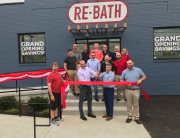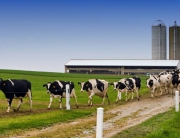Lancaster New Era
December 11, 2007
By TIM MEKEEL, New Era Staff Writer Smokestacks.
Sure, the Economic Development Co. of Lancaster County likes smokestacks. But in the past seven years, it’s gotten fond of silos too.
The EDC has become a major financier of agriculture in Lancaster County by tapping in to three recently enacted state programs.
Since 2000, it has obtained $15 million in state funds for 74 local farms, helping local farmers buy $50 million worth of land, buildings and equipment.
“We’ve done almost every kind of farm you can come across in Lancaster County,” said EDC vice president John Biemiller.
To celebrate that $50 million milestone, EDC and state officials were set to gather today at the Pequea Township dairy farm of a recent loan recipient, the Garber family.
State Agriculture Secretary Dennis Wolff and other officials planned to tour the farm and offer remarks, recognizing that EDC’s work has touched 5,000 agricultural acres here.
That’s eight square miles of farmland, an area roughly the size of Lancaster City, which have been made stronger economically by a concerted effort to access state dollars.
The EDC’s efforts have enhanced 40 dairy farms, 10 broiler farms, six crop farms, five layer farms, four hog finishing farms, two hog nurseries, two beef farms, two pullet farms, one breeder farm — even a duck farm and an alpaca farm.
EDC president David Nikoloff credited Biemiller and program manager Lyle Hosler for bringing local farmers and the state loan programs together.
“You can put the shingle out and do all the marketing you want. But without the people and the infrastructure to respond, nothing happens,” said Nikoloff, adding that area banks and specialty contractors have been highly supportive too.
Typically, the state programs, area banks and the farmers themselves each fund part of a project’s cost.
With the state’s participation, though, the banks and farmers have smaller stakes and lesser risks.
The three state programs are the Next Generation Farmer program, started in 2000 to help farmers buy their first acres, and the First Industries Fund, whose Small Business First program and Machinery & Equipment Loan Fund have helped farmers buy more acres, buildings and equipment since 2005.
EDC staffers meet with the farmers and their bankers to assess the proposed venture.
“Often we literally sit at the kitchen table,” said Biemiller.
Assuming the proposal is deemed viable, the EDC staffers fill out the necessary documents and submit them to the board of the EDC’s business-financing arm, EDC Finance Corp.
If the EDC Finance board approves, the board forwards the application to the state for its consideration and, hopefully, its approval.
That’s a frequent exercise for the EDC Finance board, even if you factor in Lancaster County’s status as the state’s most productive agricultural county.
The EDC has secured 53 First Industries ag loans for local farmers over the program’s history, more than twice the next highest volumes secured by other groups serving other markets.
Those runners-up are Adams County farmers (23) and Chester County farmers (18), said Hosler.
Likewise, EDC is the largest provider of Next Generation loans. Local farmers, working through EDC, will receive all $3 million of Next Generation funds allocated statewide this year.
Through those programs, EDC now does about 20 ag projects a year — about half of its total, which includes brownfield remediation, urban redevelopment and industrial expansion projects.
The ag projects, explained Nikoloff, have specific purposes.
“We’re not refinancing debt. We’re not providing operating capital. It’s all about the acquisition of, and investment in, hard assets — land, building and equipment,” he said.
Nikoloff explained that the rationale behind the ag loans is the same as industrial loans, because farms and factories are both businesses trying to achieve the same goal — make a profit.
“If we can provide a more attractive cost structure to a business and improve its ability to weather the economic changes and be competitive, then we’ve achieved our purpose,” he said.
And just like any businessperson, local farmers use more than hard work to succeed, especially in the face of competition from far larger farms elsewhere that have the advantage of economies of scale.
“It’s the person who’s able to apply technology and capital in advanced ways who’s surviving. … These are truly sophisticated business people,” said Nikoloff.
Illustrating that concept are Dave Garber, his wife Shirley, his brother Joe, Joe’s wife Yvonne, and their son Josiah.
Their Spring Lawn Farm at 248 Stoney Lane recently completed a $3 million expansion, including the installation of a robotic, voluntary milking system, the county’s first.
The project was completed with the help of $700,000 in state First Industries Fund loans obtained through EDC.
Although the venture will increase the size of their dairy herd from 155 to 275 cows, and has included construction of a new barn, silo and milking parlor, the highlight is the milking system.
Cows, when they feel the need to be milked, walk on their own to the robotic milking equipment. That makes it “voluntary.”
Computer chips put on their ears are read by the system, to track the cows’ output and make sure enough time has passed since the cows were last milked.
“That’s a real investment,” said Nikoloff, noting the project reflects the capital-intensive nature of today’s farming. “It’s not Grant Wood’s ‘American Gothic’ anymore.”
Staff writer Tim Mekeel can be reached at tmekeel@LNPnews.com or 481-6030.
copyright © Lancaster New Era. Used with permission.






Recent Comments